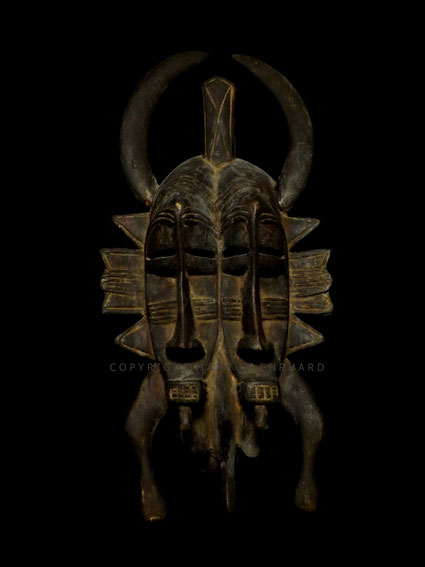Yalourga Soro
No life data is known yet about Koulé Yalourga Soro from Ganaoni. Comparing his masks with other carvers of the region Boundiali, Yalourga was aware and certainly influenced by the work of Sabariko Koné from Ouézomon (read the blog article "The Sabariko Koné - Standard", of Fossoungo Dagnogo from Kalaha, who died in 1979, and Songuifolo Silué from Sirasso. Most probable Songuifolo and Yalourga were carvers in the same period of time, because they both did work in two styles, masks with all the traditional features and a reduced pure style.
Typical for the puristic elements are the blind side decorations with no additional decorating like rills or hatches, a simple shaped face with no add-on like scars. A rare single and a double faced mask in an excellent quality is shown in this profile of Yalourga. Both masks were made in the same period.
Yalourga was very productive, but he was not a popular carver like Sabariko. Yalourga is most known for his outstanding doublefaced Kpelié masks, the Yêchikpleyégué. The distinctive mark of his masks are the very tiny and very narrow faces, where one is carved exactly like the second one. The Yêchikpleyégué is a public mask in Senufo ritus, that can be seen by everyone at a ceremony, where the birth of twins is celebrated. Yalourga often uses the Calao on top as symbol for wisdom. The legend says, that when a Calao does pic the human forehead, the person receives knowledge and sageness. That is, why all Kpelié masks have this convex mark in the middle of the forehead.
Yalourga was brilliant in carving Kpelié masks, but his statues are different. He was influenced by Sabariko Koné. Yalourga had problems to carve similar faces of the woman and man, which is a characteristic handwriting. In his statues he did not differenciate between traditional and pure style like Songuifolo Silué did.
All his sculptures feature the traditional Senufo elements. The single Tugubele for example holds the sword/knife in his right hand, which symbolizes the weapon to kill a chicken. The bowl in the right hand is to hold rice to feed the children (from: Kunst & Kontext, Ausgabe 4 2012, Zangvagnan Koné in an interview with Karl-Heinz Krieg, article by Dr. Andreas Schlothauer).
Also typical for Yalourga Soro's carving is the finish: After treating a statue or mask with black stain, he used Karité-butter to cover the complete object. The surface is greasy and slippery. This gives some objects a grey and crusty surface.
Comparing his Kpelié there is a change in his development process. Early carved masks from a time period of 1940 till around 1960 show all the classic and traditional features of the Kpelié mask. In his late years he developed a more modern abstract style of the Kpelié with reduced shapes of the classic decoration elements. He even changed the back of the his masks, where in the lower part does show an edge. The rare single faced mask is an example of this late style. Fossoungo Dagnogo and Songuifolo Silué did the same decoration elements between 1960 and 1970. Most likely Yalourga was influenced by these two carvers.

Male Tugubele, carved by Yalourga Soro, Ganaoni.
27,5 x 7,0 x 7,5 cm, wood.
Literature:
- Wenn Neuordnung Ordnung schafft, Markus Ehrhard, pages 142 - 143.

Tugubele couple, carved by Yalourga Soro, Ganaoni. Early work, between 1940 and 1950.
Woman: 20,5 x 4,5 x 4,0 cm, wood.
Man: 20,5 x 4,5 x 4,0 cm, wood.
Literature:
- Wenn Urform Form bestimmt, Markus Ehrhard, pages 22 - 23, 136 - 137.

Tugubele couple, carved by Yalourga Soro, Ganaoni.
17,5 x 7,5 x 6,0 cm, wood.
Literature:
Not published yet.

Yêchikpleyégué, doublefaced Kpelié mask, carved by Yalourga Soro, Ganaoni. Early work, between 1940 and 1950.
32,5 x 11,5 x 5,0 cm, wood.
Literature:
- Wenn Neuordnung Ordnung schafft, Markus Ehrhard, pages 144 - 145.

Yêchikpleyégué, doublefaced Kpelié mask, carved by Yalourga Soro, Ganaoni.
33,5 x 11,5 x 5,5 cm, wood.
Literature:
not published yet

Yêchikpleyégué, doublefaced Kpelié mask, carved by Yalourga Soro, Ganaoni.
30,0 x 14,5 x 6,0 cm, wood.
Literature:
not published yet

Yêchikpleyégué, doublefaced Kpelié mask with a Tugubele couple on top, carved by Yalourga Soro, Ganaoni.
33,0 x 13,0 x 5,0 cm, wood.
Literature:
not published yet

Yêchikpleyégué, doublefaced Kpelié mask, carved by Yalourga Soro, Ganaoni.
32,5 x 14,0 x 6,0 cm, wood.
Literature:
- Wenn Neuordnung Ordnung schafft, Markus Ehrhard, pages 146 - 147.

Yêchikpleyégué, doublefaced Kpelié mask, carved by Yalourga Soro, Ganaoni.
25,0 x 15,5 x 7,5 cm, wood.
Literature:
- Wenn Urform Form bestimmt, Markus Ehrhard, pages 138 - 139.

Yêchikpleyégué, doublefaced Kpelié mask, carved by Yalourga Soro, Ganaoni.
29,5 x 14,0 x 6,5 cm, wood. Pure style, late period.
Literature:
not published yet

Rare single face Kpelié mask, carved by Yalourga Soro, Ganaoni.
34,5 x 13,0 x 5,0cm, wood. Pure style, late period.
Literature:
not published yet.

Rare variation of the Kpelié mask, carved by Yalourga Soro, Ganaoni.
38,0 x 14,0 x 8,0cm, wood.
Literature:
not published yet.

Welcome to the first archive documentating the artwork of 26 named Senufo carvers from 1900 till today. We present antique and recent sculptures of so-called masters and not that famous carvers.
All our images have copyright markings. Feel free to download our content and images. In case you publish or share our content or an image on other platforms, like Facebook or Pinterest, please name the source and link to this website. All images are highly detailed printed with more information in our books, available at Ornito.

